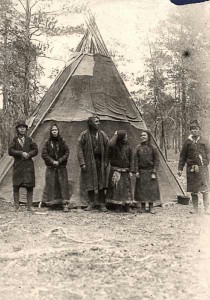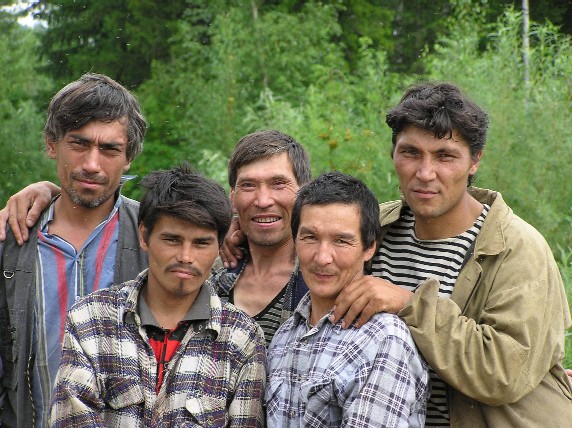Back in the mid-1980’s, I became very interested in the native cultures of Siberia, partly because they have many similarities with the native cultures of northern Canada. I went so far as to correspond with several people in Siberia, something which was just then beginning to be possible. This was necessary, because there was then very little information available in English or French about this region, most of which had been sealed off by the Communist regime for most of the century. Some very nasty things happened there, not the least of which was the wholesale suppression and destruction of native cultures. I dug up the small number of relevant books and articles that I could, but there wasn’t much to be found.
Among the many native cultures of Siberia, the most isolated and little known is that of the people called Ket, who live along the middle Yenisei River of central Siberia. This is not far from the remote region where the notorious “Tunguska Event” of 1905 took place (now generally thought to have been the collision of a comet fragment with the Earth). They speak the only surviving member of the Yeniseian language family. This is considered a “linguistic isolate” — a language with no know affiliation with any other languages. At the time I first turned my curiosity in their direction, there were occasional speculations that it was remotely connected to the Tibeto-Burman language family. Now, however, the trend is to look for a possible connection to the Athapascan language family, which includes several languages in Canada. Edward Vajda, an American scholar, champions this position, though he concedes that he comes short of a conclusive proof.

A Ket camp in Siberia, taken in1929. A picture taken in Canada’s North West Territories in the same year would have been very similar… and Vajda proposes that the languages of both places are related.
Only about a 1,100 Ket survive today, among whom less than half are fluent in the language. Their social conditions are not good, and pressures to assimilate into Russian culture are strong. All the Siberian native peoples have been able to recover culturally a bit, since the end of the old Soviet regime, but a group with such a small population base is in a comparatively weak position compared to larger groups. They also stand apart from other Siberian peoples, and cannot appeal to any broader solidarity. They are so remote, that few outsiders have had any contact with them. But the information situation has greatly improved. Vajda’s enthusiastic and careful scholarship extends to culture and folkways, as well as to their language. He obviously has great affection for the Ket, and communicates this in his writing. The first book deals not only with Ket, but with the other members of the language family that are known to have existed, but are now extinct. It’s extensive bibliography shows that there is now much more material available to anyone curious about the Ket. The second book is primarily a linguistic analysis of Ket, but it also contains some ethnographic description. This passage caught my eye:
Before Stalin’s forced collectivization and sedentarization of Siberian native groups in the 1930s and Khrushchev’s consolidation of the resultant Ket settlements into larger, multi-ethnic villages in the early 1960s, the Ket represented the last island of true hunter-gatherer-fishers anywhere in Northern Eurasia outside the Pacific Rim. The traditional Ket economic cycle perhaps offers something akin to a glimpse into the remote prehistory of the Eurasian interior. In spring, several Ket families would converge to erect their teepee-like birchbark tents beside the rivers, lakes, and other fishing sites. During the intense, brief summer heat, some took up residence in large covered houseboats, which they maneuvred out into the deep current beyond the clouds of bloodsucking insects infesting the river banks. Fall and early winter were a time of wandering, when the group bid farewell to the river and dispersed back to the taiga interior. Many sailed up the Yenisei’s tributaries to reach their traditional hunting grounds. Each family had its own hunting trail. The men would journey into the forest to hunt reindeer, elk, or bear, as well as fur-bearing animals and game birds. Accompanied by their dogs, hunters traveled on foot, each day moving a bit farther from their family’s encampment. During the coldest months, when daylight was shortest, hunting would virtually cease and families subsisted on their stored provisions. The entire group waited out this cold, dark period in a kind of semi-subterranean dwelling of extremely archaic design. When the days began to lengthen again, the hunters resumed their forays. Leaving their women, children, and elderly family members for successively longer periods each trip, the men traversed long distances on wide, padded skis, dragging their supplies behind them on a hand sled. After the spring thaw, the Ket would reoccupy their fishing sites at the water’s edge. These subsistence patterns, recorded in the early 20th century, provide a view of daily life as it must have existed before the Turko-Mongol pastoralists and Samoyedic or Tungusic reindeer herding lifestyles came to dominate every other corner of land-locked North Asia.
I can practically smell the snow and the tamarack while I read this. Anyone with experience of the Canadian north would recognize every element in this description — except for the notable absence of dog-sleds. It is all the more fitting that a direct linguistic connection between Canada and the Ket might exist.

0 Comments.